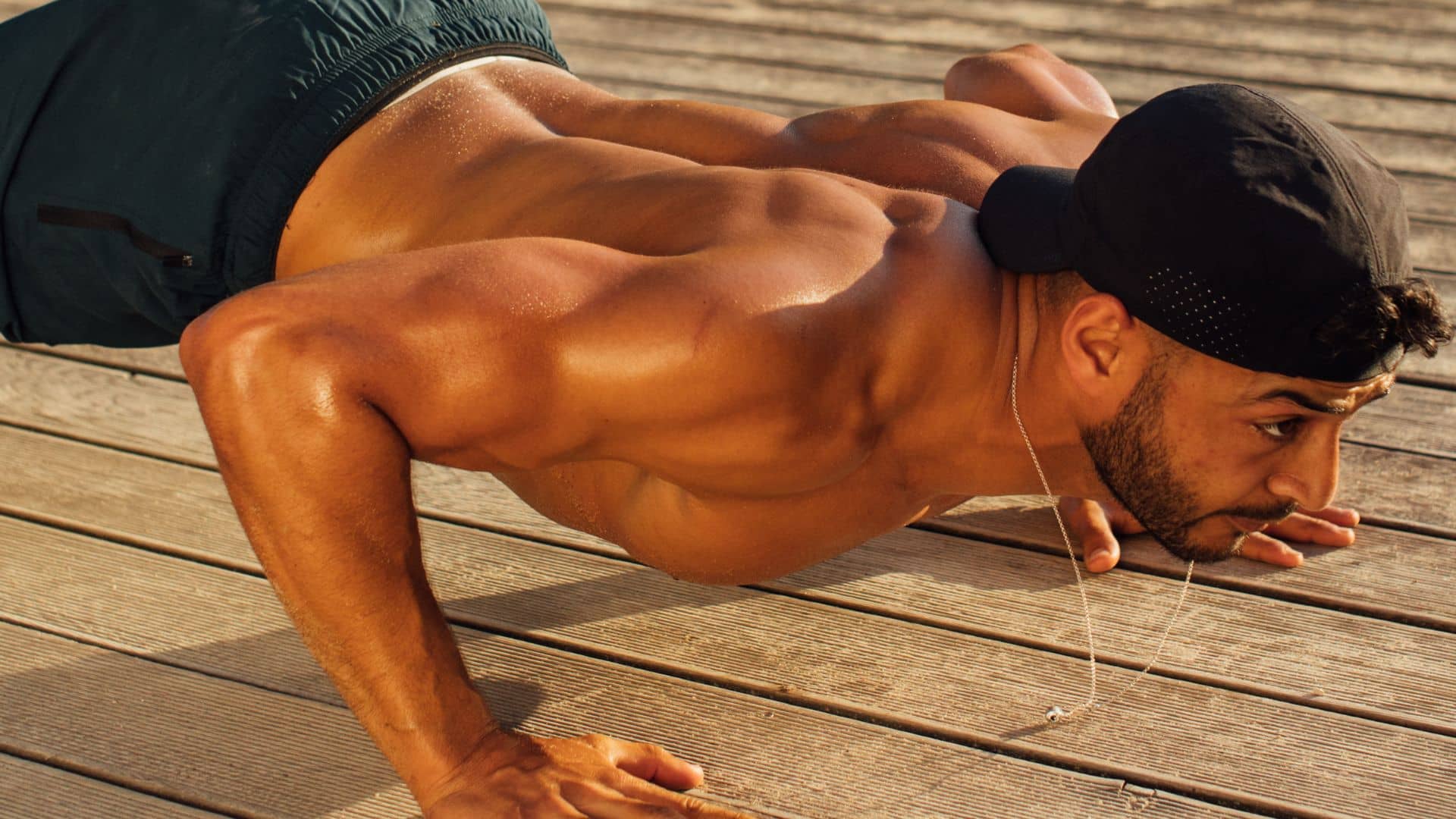Here are 5 reasons why you might be having trouble doing push-ups correctly: weak core muscles, poor upper body strength, incorrect hand placement, improper breathing, and lack of practice. Nevertheless, If you’re new to push-ups or haven’t done them in a while, it may take time to build up the strength and technique needed to perform them correctly.
Weak Core Muscles.
So, let me explain this further. The core muscles are the muscles that make up your stomach, lower back, and hips. These muscles work together to stabilize your body and maintain good posture.
When you perform a push-up, your core muscles are engaged throughout the entire movement to keep your body in a straight line.
If your core muscles are weak, you may struggle to maintain proper form while doing push-ups. For example, if your core is not strong enough to keep your hips level with the rest of your body, your hips may sag, causing your lower back to arch.
This not only puts unnecessary strain on your lower back, but it also takes the focus away from the intended muscles being worked (chest, shoulders, and triceps).
Additionally, when your core is weak, your body is more likely to compensate for the lack of strength by using other muscles to complete the exercise.
This can lead to incorrect form and can make the exercise less effective.
Therefore, it’s important to have a strong core to perform push-ups correctly and to avoid injury.
Incorporating exercises that target your core, such as planks and crunches, can help improve your core strength and make push-ups easier to execute with proper form.
Poor upper body strength issue.
Yes, that’s correct. Push-ups require a significant amount of upper body strength, particularly in the chest, shoulders, and triceps, to perform correctly.
These muscles are responsible for pushing your body weight off the ground and back down again.
If you have weak upper body strength in these areas, you may not be able to perform the exercise correctly.
For example, you may struggle to lower your body down to the ground and push back up, or you may not be able to maintain proper form throughout the exercise.
Weak upper body strength can make it difficult to complete multiple reps of push-ups, which can limit your ability to progress and improve your strength over time.
To improve your upper body strength for push-ups, it’s important to incorporate strength training exercises that target these muscles.
For example, you can do chest presses, shoulder presses, and tricep extensions using weights or resistance bands. Over time, as you build strength in these areas, you should find it easier to perform push-ups correctly and with proper form.

Incorrect hand placement.
That’s right. Hand placement is a critical component of performing push-ups correctly.
If your hands are not in the correct position, it can cause strain on your shoulders, wrists, and elbows, which can lead to incorrect form and potential injury.
When performing push-ups, your hands should be shoulder-width apart, with your fingers facing forward or slightly outward.
This hand placement allows for proper alignment of the shoulders, elbows, and wrists, and ensures that the load is evenly distributed throughout the upper body.
If your hands are too close together, it can cause strain on your wrists and elbows, leading to discomfort and potential injury.
On the other hand, if your hands are too far apart, it can place too much strain on your shoulders, making it difficult to maintain proper form throughout the exercise.
It’s important to experiment with different hand placements to find what works best for you, but generally speaking, shoulder-width apart is a good starting point for most people.
By maintaining proper hand placement, you can perform push-ups with proper form and reduce the risk of injury.
Improper breathing.
Breathing is an essential part of any exercise, and push-ups are no different. If you’re not breathing correctly during push-ups, it can lead to a lack of oxygen to your muscles, which can cause you to struggle with the exercise.
During a push-up, it’s important to inhale as you lower your body towards the ground, and exhale as you push yourself back up.
This breathing pattern helps to ensure that your muscles are getting enough oxygen to support the movement, and it can also help you maintain proper form.
If you’re holding your breath or breathing in a shallow manner during push-ups, it can cause you to fatigue more quickly and struggle with the exercise.
It’s important to focus on your breath and take deep, controlled breaths throughout the movement.
In addition to proper breathing during the exercise, it’s also important to make sure you’re breathing correctly throughout the day.
Deep breathing exercises can help improve your lung capacity and oxygen intake, which can benefit your overall fitness and help you perform push-ups with greater ease.
Lack of practice.
Like any exercise, push-ups require practice to get the technique right and build up the strength needed to perform them correctly.
If you’re new to push-ups or haven’t done them in a while, it’s important to take things slowly and build up gradually to avoid injury and frustration.
It’s important to start with modified push-ups, where you perform the exercise on your knees instead of your toes.
This modification reduces the amount of weight you’re pushing, making it easier to perform the exercise correctly. As you build strength and confidence, you can gradually move to performing push-ups on your toes.
It’s also important to focus on proper form from the beginning.
This means keeping your body in a straight line from your head to your toes, engaging your core muscles, and keeping your elbows tucked in towards your body as you lower and lift yourself.
By focusing on proper form, you’ll help prevent injury and ensure that you’re getting the most benefit from the exercise.
iit’s important to practice regularly. Aim to include push-ups in your workout routine at least a few times a week, starting with just a few reps and gradually building up over time.
By practicing regularly, you’ll build strength and technique, and soon you’ll be able to perform push-ups with ease.
Here is a chart table that lists 15 common mistakes when performing push-ups, along with their potential causes and fixes:
| Mistake | Potential Cause | Fix |
|---|---|---|
| 1. Improper hand placement | Hands too close together or too far apart | Place hands shoulder-width apart, with fingers facing forward or slightly outward |
| 2. Arching back | Weak core muscles | Engage core muscles and keep body in a straight line |
| 3. Dropping head or hips | Improper form or lack of core strength | Focus on keeping head and hips in line with the rest of the body |
| 4. Not breathing correctly | Lack of oxygen to muscles | Inhale as you lower yourself, exhale as you push up |
| 5. Flaring elbows out | Improper form or lack of shoulder strength | Keep elbows tucked in towards the body |
| 6. Not engaging core muscles | Lack of core strength or focus | Engage core muscles throughout the exercise |
| 7. Allowing hips to sag | Lack of core strength or improper form | Keep hips in line with the rest of the body |
| 8. Not going low enough | Lack of strength or improper form | Lower yourself until your chest almost touches the ground |
| 9. Rushing through reps | Lack of focus or proper form | Slow down and focus on proper form |
| 10. Leaning too far forward | Lack of core strength or improper form | Keep body in a straight line from head to toe |
| 11. Not warming up properly | Lack of mobility or muscle activation | Perform a dynamic warm-up that includes shoulder and core exercises |
| 12. Overtraining | Lack of rest or recovery time | Allow adequate rest and recovery time between workouts |
| 13. Not progressing gradually | Lack of strength or proper form | Gradually increase the number of reps and difficulty level of push-ups |
| 14. Not incorporating variety | Plateauing or lack of muscle activation | Include different types of push-ups and variations to target different muscles |
| 15. Lack of practice | Lack of strength or technique | Start with modified push-ups and gradually progress to full push-ups |
By identifying and addressing these common mistakes, you can perform push-ups with proper form and reduce the risk of injury, while also building strength and endurance over time.
Conclusion
In conclusion, push-ups are a versatile and effective exercise that can help you build strength and endurance in various muscle groups.
However, it’s important to perform them correctly to avoid injury and get the most out of the exercise.
By fixing these common mistakes, such as improper hand placement, arching the back, or not engaging the core, you can improve your form and technique, and take your push-ups to the next level.
Remember to progress gradually, incorporate variety, and practice regularly to build your strength and see results. So, start fixing these mistakes today and get ready to see the benefits of this classic exercise.


